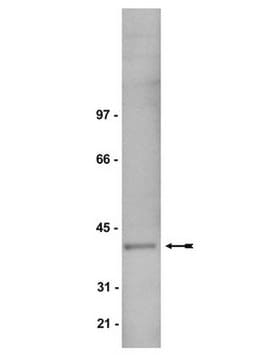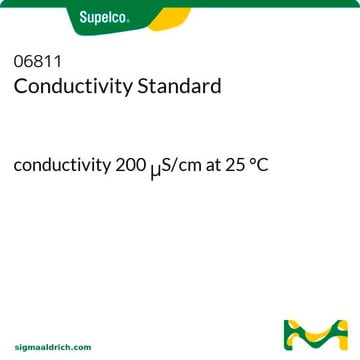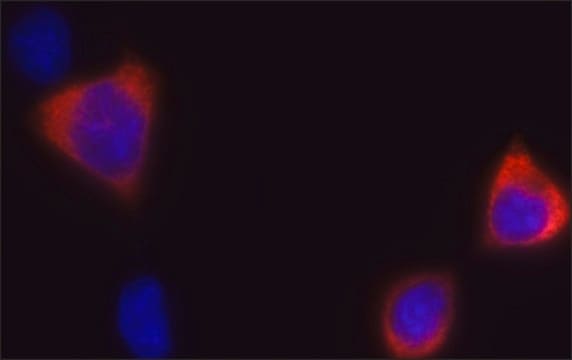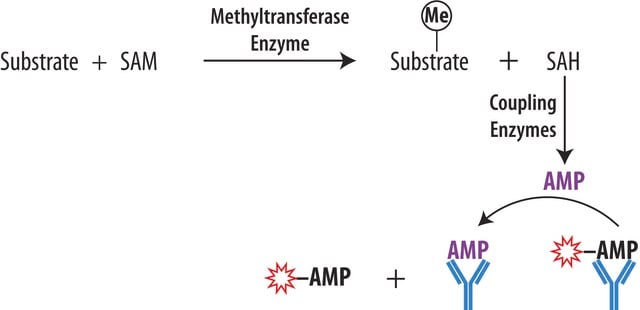03-249
RIPAb+ Ago1 Antibody
clone 4G7-E12, from mouse
Synonym(s):
hAgo1, Argonaute1, eIF-2C 1, eIF2C 1, Q99, GERP95, DKFZp686M13167
Sign Into View Organizational & Contract Pricing
All Photos(3)
About This Item
UNSPSC Code:
12352203
eCl@ss:
32160702
NACRES:
NA.32
Recommended Products
General description
RIPAb+ antibodies are evaluated using the RNA Binding Protein Immunoprecipitation (RIP) assay. Each RIPAb+ antibody set includes a negative control antibody to ensure specificity of the RIP reaction and is verified for the co-immunoprecipitation of RNA associated specifically with the immunoprecipitated RNA-binding protein of interest. Where appropriate, the RIPAb+ set also includes quantitative RT-PCR control primers (RIP Primers) to biologically validate your IP results by successfully co-precipitating the specific RNA targets, such as messenger RNAs. The qPCR protocol and primer sequences are provided, allowing researchers to validate RIP protocols when using the antibody in their experimental context. If a target specific assay is not provided, the RIPAb+ kit is validated using an automated microfluidics-based assay by enrichment of detectable RNA over control immunoprecipitation.
Ago1 (Eukaryotic translation initiation factor 2C 1) is a member of the argonaute family. It contains a PAZ and a PIWI domain, and is required for G1 arrest and mating in response to nitrogen starvation. It may also contribute to cell cycle control by regulating cytokinesis. Ago1 is also needed for the production of mature miRNA that affects miRNA-directed RNA cleavage and is therefore important for heterchromatin formation and accurate chromosome segregation.
Ago1 (Eukaryotic translation initiation factor 2C 1) is a member of the argonaute family. It contains a PAZ and a PIWI domain, and is required for G1 arrest and mating in response to nitrogen starvation. It may also contribute to cell cycle control by regulating cytokinesis. Ago1 is also needed for the production of mature miRNA that affects miRNA-directed RNA cleavage and is therefore important for heterchromatin formation and accurate chromosome segregation.
Specificity
This antibody has been shown by an independent laboratory to not cross react with Ago2, Ago3, or Ago4 (Azuma-Mukai A et al. (2008) Proc. Natl. Acad. Sci. USA 105: 7964-7969).
Immunogen
GST-tagged recombinant protein corresponding to human Ago1
Application
RNA Binding Protein Immunoprecipitation (microRNA):
Representative lot data.
RIP Lysate prepared from 293 cells (2 X 107 cell equivalents per IP) were subjected to immunoprecipitation using 5 µg of either a normal mouse IgG (Cat. # CS200621), or Anti-Ago1 antibody (Cat. # CS207365) and the Magna RIP RNA-Binding Protein Immunoprecipitation Kit (Cat. # 17-700).
Successful immunoprecipitation of Ago 1-associated microRNA was verified by TaqMan microRNA assay, hsa-miR-15a. (Figure2). Please refer to the Magna RIP (Cat. # 17-700) or EZ-Magna RIP (Cat. # 17-701) protocol for experimental details.
Western Blot Analysis:
Representative lot data.
HeLa cell lysate was probed with Anti-Ago 1, clone 4G7-E12 (0.1 µg/mL). Proteins were visualized using a Goat Anti-Mouse IgG secondary antibody conjugated to HRP and a chemiluminescence detection system.
Arrow indicates Ago 1 (~97 kDa).
Representative lot data.
RIP Lysate prepared from 293 cells (2 X 107 cell equivalents per IP) were subjected to immunoprecipitation using 5 µg of either a normal mouse IgG (Cat. # CS200621), or Anti-Ago1 antibody (Cat. # CS207365) and the Magna RIP RNA-Binding Protein Immunoprecipitation Kit (Cat. # 17-700).
Successful immunoprecipitation of Ago 1-associated microRNA was verified by TaqMan microRNA assay, hsa-miR-15a. (Figure2). Please refer to the Magna RIP (Cat. # 17-700) or EZ-Magna RIP (Cat. # 17-701) protocol for experimental details.
Western Blot Analysis:
Representative lot data.
HeLa cell lysate was probed with Anti-Ago 1, clone 4G7-E12 (0.1 µg/mL). Proteins were visualized using a Goat Anti-Mouse IgG secondary antibody conjugated to HRP and a chemiluminescence detection system.
Arrow indicates Ago 1 (~97 kDa).
Research Category
Epigenetics & Nuclear Function
Epigenetics & Nuclear Function
Research Sub Category
RNA Binding Protein (RBP)
RNA Binding Protein (RBP)
This RIPAb+ Ago1 -RIP Validated Antibody & Primer Set conveniently includes the antibody & the specific control PCR primers.
Packaging
10 assays per set. Recommended use: ~5 µg of antibody per RIP (dependent upon biological context).
Quality
RNA Binding Protein Immunoprecipitation:
Representative lot data
RIP Lysate prepared from 293 cells (2 X 10E7 cell equivalents per IP) were subjected to immunoprecipitation using 5 µg of either a normal mouse IgG, or 5 µg Anti-Ago1 antibody and the Magna RIP® RNA-Binding Protein Immunoprecipitation Kit (Cat. # 17-700).
Successful immunoprecipitation of Argonaute 1-associated RNA was verified by qPCR using RIP Primers IGF2, (Figure 1).
Please refer to the Magna RIP (Cat. # 17-700) or EZ-Magna RIP (Cat. # 17-701) protocol for experimental details.
Representative lot data
RIP Lysate prepared from 293 cells (2 X 10E7 cell equivalents per IP) were subjected to immunoprecipitation using 5 µg of either a normal mouse IgG, or 5 µg Anti-Ago1 antibody and the Magna RIP® RNA-Binding Protein Immunoprecipitation Kit (Cat. # 17-700).
Successful immunoprecipitation of Argonaute 1-associated RNA was verified by qPCR using RIP Primers IGF2, (Figure 1).
Please refer to the Magna RIP (Cat. # 17-700) or EZ-Magna RIP (Cat. # 17-701) protocol for experimental details.
Target description
~97 kDa
Physical form
Anti-Ago1 (Mouse Monoclonal). One vial containing 50 µg protein G purified monoclonal in buffer containing 0.1 M Tris-glycine (pH 7.4), 150mM NaCl, 0.05% sodium azide before the addition of glycerol to 30%. Store at -20° C.
Concentration: 0.7 mg/mL
Normal mouse IgG. One vial containing 125 µg purified mouse IgG in 125 µL storage buffer containing 0.1% sodium azide. Store at -20°C.
RIP Primer IGF2. One vial containing 75 μL of 5 μM of each primer specific for human IGF2 mRNA. Store at -20°C.
FOR: GCG GCT TCT ACT TCA GCA G
REV: CAG GTG TCA TAT TGG AAG AAC
Concentration: 0.7 mg/mL
Normal mouse IgG. One vial containing 125 µg purified mouse IgG in 125 µL storage buffer containing 0.1% sodium azide. Store at -20°C.
RIP Primer IGF2. One vial containing 75 μL of 5 μM of each primer specific for human IGF2 mRNA. Store at -20°C.
FOR: GCG GCT TCT ACT TCA GCA G
REV: CAG GTG TCA TAT TGG AAG AAC
Format: Purified
Protein G Purified
Storage and Stability
Stable for 1 year at -20°C from date of receipt. Handling Recommendations: Upon first thaw, and prior to removing the cap, centrifuge the vial and gently mix the solution. Aliquot into microcentrifuge tubes and store at -20°C. Avoid repeated freeze/thaw cycles, which may damage IgG and affect product performance.
Note: Variability in freezer temperatures below -20°C may cause glycerol containing solutions to become frozen during storage.
Note: Variability in freezer temperatures below -20°C may cause glycerol containing solutions to become frozen during storage.
Analysis Note
Control
Includes normal mouse IgG and primers specific for human IGF2 mRNA.
Includes normal mouse IgG and primers specific for human IGF2 mRNA.
Other Notes
Concentration: Please refer to the Certificate of Analysis for the lot-specific concentration.
Legal Information
MAGNA RIP is a registered trademark of Merck KGaA, Darmstadt, Germany
UPSTATE is a registered trademark of Merck KGaA, Darmstadt, Germany
Disclaimer
Unless otherwise stated in our catalog or other company documentation accompanying the product(s), our products are intended for research use only and are not to be used for any other purpose, which includes but is not limited to, unauthorized commercial uses, in vitro diagnostic uses, ex vivo or in vivo therapeutic uses or any type of consumption or application to humans or animals.
Storage Class
10-13 - German Storage Class 10 to 13
Certificates of Analysis (COA)
Search for Certificates of Analysis (COA) by entering the products Lot/Batch Number. Lot and Batch Numbers can be found on a product’s label following the words ‘Lot’ or ‘Batch’.
Already Own This Product?
Find documentation for the products that you have recently purchased in the Document Library.
Teresa Bellissimo et al.
Cell death & disease, 10(1), 17-17 (2019-01-10)
To perform their regulatory functions, microRNAs (miRNAs) must assemble with any of the four mammalian Argonaute (Ago) family of proteins, Ago1-4, into an effector complex known as the RNA-induced silencing complex (RISC). While the mature miRNA guides the RISC complex
Jingwei Cao et al.
Cancer cell international, 20, 327-327 (2020-07-24)
Long non-coding RNAs (lncRNAs) has been extensively reported play important roles in regulating the development and progression of cancers, including Glioblastoma (GBM). LINC01426 is a novel lncRNA that has been identified as an oncogenic gene in GBM. Herein, we attempted
Our team of scientists has experience in all areas of research including Life Science, Material Science, Chemical Synthesis, Chromatography, Analytical and many others.
Contact Technical Service








